带你彻底搞懂MyBatis的底层实现之缓存模块(Cache)-吊打面试官必备技能
Posted 波波烤鸭
tags:
篇首语:本文由小常识网(cha138.com)小编为大家整理,主要介绍了带你彻底搞懂MyBatis的底层实现之缓存模块(Cache)-吊打面试官必备技能相关的知识,希望对你有一定的参考价值。
基础支持层位于MyBatis整体架构的最底层,支撑着MyBatis的核心处理层,是整个框架的基石。基础支持层中封装了多个较为通用的、独立的模块。不仅仅为MyBatis提供基础支撑,也可以在合适的场景中直接复用。
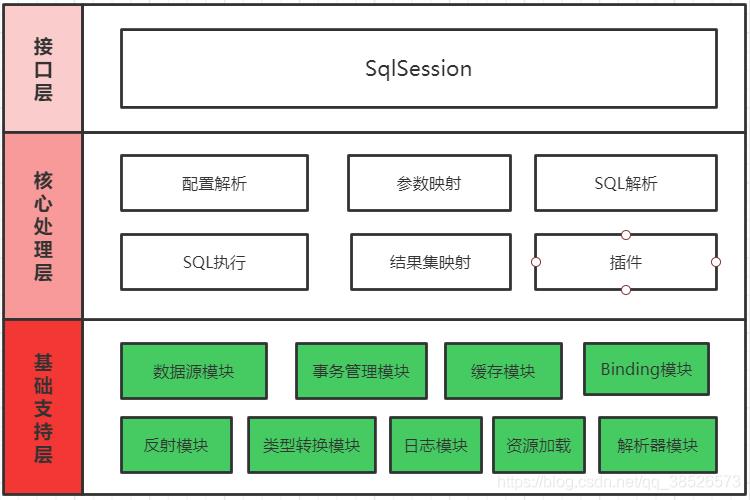
上篇文章我们给大家聊了下binding模块,本篇文章我们重点来聊下缓存(Cache)模块。
缓存模块
MyBatis作为一个强大的持久层框架,缓存是其必不可少的功能之一,Mybatis中的缓存分为一级缓存和二级缓存。但本质上是一样的,都是使用Cache接口实现的。缓存位于 org.apache.ibatis.cache包下。

通过结构我们能够发现Cache其实使用到了装饰器模式来实现缓存的处理。首先大家需要先回顾下装饰器模式的相关内容哦。我们先来看看Cache中的基础类的API
// 煎饼加鸡蛋加香肠
“装饰者模式(Decorator Pattern)是指在不改变原有对象的基础之上,将功能附加到对象上,提供了比继承更有弹性的替代方案(扩展原有对象的功能)。”

1 Cache接口
Cache接口是缓存模块中最核心的接口,它定义了所有缓存的基本行为,Cache接口的定义如下:
public interface Cache {
/**
* 缓存对象的 ID
* @return The identifier of this cache
*/
String getId();
/**
* 向缓存中添加数据,一般情况下 key是CacheKey value是查询结果
* @param key Can be any object but usually it is a {@link CacheKey}
* @param value The result of a select.
*/
void putObject(Object key, Object value);
/**
* 根据指定的key,在缓存中查找对应的结果对象
* @param key The key
* @return The object stored in the cache.
*/
Object getObject(Object key);
/**
* As of 3.3.0 this method is only called during a rollback
* for any previous value that was missing in the cache.
* This lets any blocking cache to release the lock that
* may have previously put on the key.
* A blocking cache puts a lock when a value is null
* and releases it when the value is back again.
* This way other threads will wait for the value to be
* available instead of hitting the database.
* 删除key对应的缓存数据
*
* @param key The key
* @return Not used
*/
Object removeObject(Object key);
/**
* Clears this cache instance.
* 清空缓存
*/
void clear();
/**
* Optional. This method is not called by the core.
* 缓存的个数。
* @return The number of elements stored in the cache (not its capacity).
*/
int getSize();
/**
* Optional. As of 3.2.6 this method is no longer called by the core.
* <p>
* Any locking needed by the cache must be provided internally by the cache provider.
* 获取读写锁
* @return A ReadWriteLock
*/
default ReadWriteLock getReadWriteLock() {
return null;
}
}
Cache接口的实现类很多,但是大部分都是装饰器,只有PerpetualCache提供了Cache接口的基本实现。
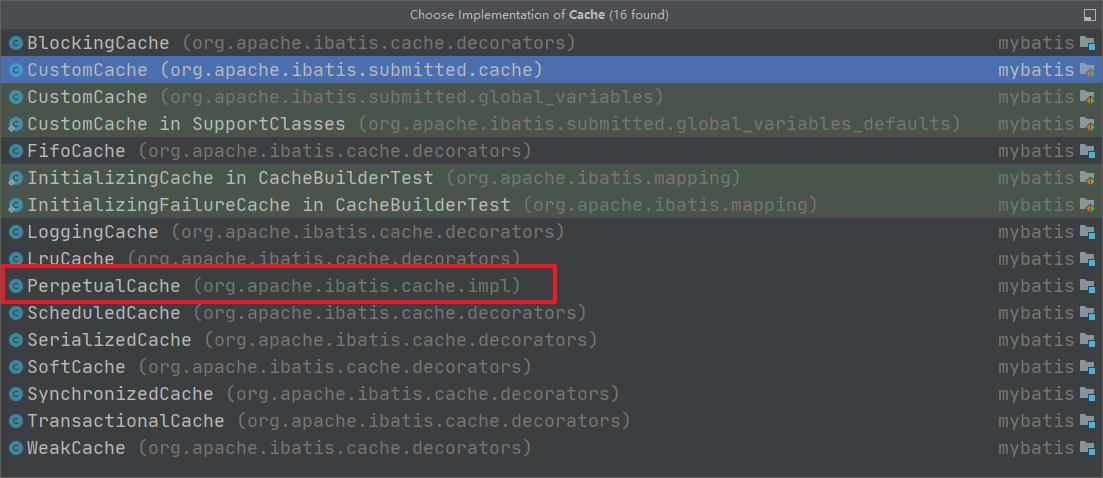
2 PerpetualCache
PerpetualCache在缓存模块中扮演了ConcreteComponent的角色,其实现比较简单,底层使用HashMap记录缓存项,具体的实现如下:
/**
* 在装饰器模式用 用来被装饰的对象
* 缓存中的 基本缓存处理的实现
* 其实就是一个 HashMap 的基本操作
* @author Clinton Begin
*/
public class PerpetualCache implements Cache {
private final String id; // Cache 对象的唯一标识
// 用于记录缓存的Map对象
private final Map<Object, Object> cache = new HashMap<>();
public PerpetualCache(String id) {
this.id = id;
}
@Override
public String getId() {
return id;
}
@Override
public int getSize() {
return cache.size();
}
@Override
public void putObject(Object key, Object value) {
cache.put(key, value);
}
@Override
public Object getObject(Object key) {
return cache.get(key);
}
@Override
public Object removeObject(Object key) {
return cache.remove(key);
}
@Override
public void clear() {
cache.clear();
}
@Override
public boolean equals(Object o) {
if (getId() == null) {
throw new CacheException("Cache instances require an ID.");
}
if (this == o) {
return true;
}
if (!(o instanceof Cache)) {
return false;
}
Cache otherCache = (Cache) o;
// 只关心ID
return getId().equals(otherCache.getId());
}
@Override
public int hashCode() {
if (getId() == null) {
throw new CacheException("Cache instances require an ID.");
}
// 只关心ID
return getId().hashCode();
}
}
然后我们可以来看看cache.decorators包下提供的装饰器。他们都实现了Cache接口。这些装饰器都在PerpetualCache的基础上提供了一些额外的功能,通过多个组合实现一些特殊的需求。
3 BlockingCache
通过名称我们能看出来是一个阻塞同步的缓存,它保证只有一个线程到缓存中查找指定的key对应的数据。
public class BlockingCache implements Cache {
private long timeout; // 阻塞超时时长
private final Cache delegate; // 被装饰的底层 Cache 对象
// 每个key 都有对象的 ReentrantLock 对象
private final ConcurrentHashMap<Object, ReentrantLock> locks;
public BlockingCache(Cache delegate) {
// 被装饰的 Cache 对象
this.delegate = delegate;
this.locks = new ConcurrentHashMap<>();
}
@Override
public String getId() {
return delegate.getId();
}
@Override
public int getSize() {
return delegate.getSize();
}
@Override
public void putObject(Object key, Object value) {
try {
// 执行 被装饰的 Cache 中的方法
delegate.putObject(key, value);
} finally {
// 释放锁
releaseLock(key);
}
}
@Override
public Object getObject(Object key) {
acquireLock(key); // 获取锁
Object value = delegate.getObject(key); // 获取缓存数据
if (value != null) { // 有数据就释放掉锁,否则继续持有锁
releaseLock(key);
}
return value;
}
@Override
public Object removeObject(Object key) {
// despite of its name, this method is called only to release locks
releaseLock(key);
return null;
}
@Override
public void clear() {
delegate.clear();
}
private ReentrantLock getLockForKey(Object key) {
return locks.computeIfAbsent(key, k -> new ReentrantLock());
}
private void acquireLock(Object key) {
Lock lock = getLockForKey(key);
if (timeout > 0) {
try {
boolean acquired = lock.tryLock(timeout, TimeUnit.MILLISECONDS);
if (!acquired) {
throw new CacheException("Couldn't get a lock in " + timeout + " for the key " + key + " at the cache " + delegate.getId());
}
} catch (InterruptedException e) {
throw new CacheException("Got interrupted while trying to acquire lock for key " + key, e);
}
} else {
lock.lock();
}
}
private void releaseLock(Object key) {
ReentrantLock lock = locks.get(key);
if (lock.isHeldByCurrentThread()) {
lock.unlock();
}
}
public long getTimeout() {
return timeout;
}
public void setTimeout(long timeout) {
this.timeout = timeout;
}
}
通过源码我们能够发现,BlockingCache本质上就是在我们操作缓存数据的前后通过 ReentrantLock对象来实现了加锁和解锁操作。其他的具体实现类,大家可以自行查阅
| 缓存实现类 | 描述 | 作用 | 装饰条件 |
|---|---|---|---|
| 基本缓存 | 缓存基本实现类 | 默认是PerpetualCache,也可以自定义比如RedisCache、EhCache等,具备基本功能的缓存类 | 无 |
| LruCache | LRU策略的缓存 | 当缓存到达上限时候,删除最近最少使用的缓存(Least Recently Use) | eviction=“LRU”(默认) |
| FifoCache | FIFO策略的缓存 | 当缓存到达上限时候,删除最先入队的缓存 | eviction=“FIFO” |
| SoftCacheWeakCache | 带清理策略的缓存 | 通过JVM的软引用和弱引用来实现缓存,当JVM内存不足时,会自动清理掉这些缓存,基于SoftReference和WeakReference | eviction="SOFT"eviction=“WEAK” |
| LoggingCache | 带日志功能的缓存 | 比如:输出缓存命中率 | 基本 |
| SynchronizedCache | 同步缓存 | 基于synchronized关键字实现,解决并发问题 | 基本 |
| BlockingCache | 阻塞缓存 | 通过在get/put方式中加锁,保证只有一个线程操作缓存,基于Java重入锁实现 | blocking=true |
| SerializedCache | 支持序列化的缓存 | 将对象序列化以后存到缓存中,取出时反序列化 | readOnly=false(默认) |
| ScheduledCache | 定时调度的缓存 | 在进行get/put/remove/getSize等操作前,判断缓存时间是否超过了设置的最长缓存时间(默认是一小时),如果是则清空缓存–即每隔一段时间清空一次缓存 | flushInterval不为空 |
| TransactionalCache | 事务缓存 | 在二级缓存中使用,可一次存入多个缓存,移除多个缓存 | 在TransactionalCacheManager中用Map维护对应关系 |
4 缓存的应用
4.1 缓存对应的初始化
在Configuration初始化的时候会为我们的各种Cache实现注册对应的别名
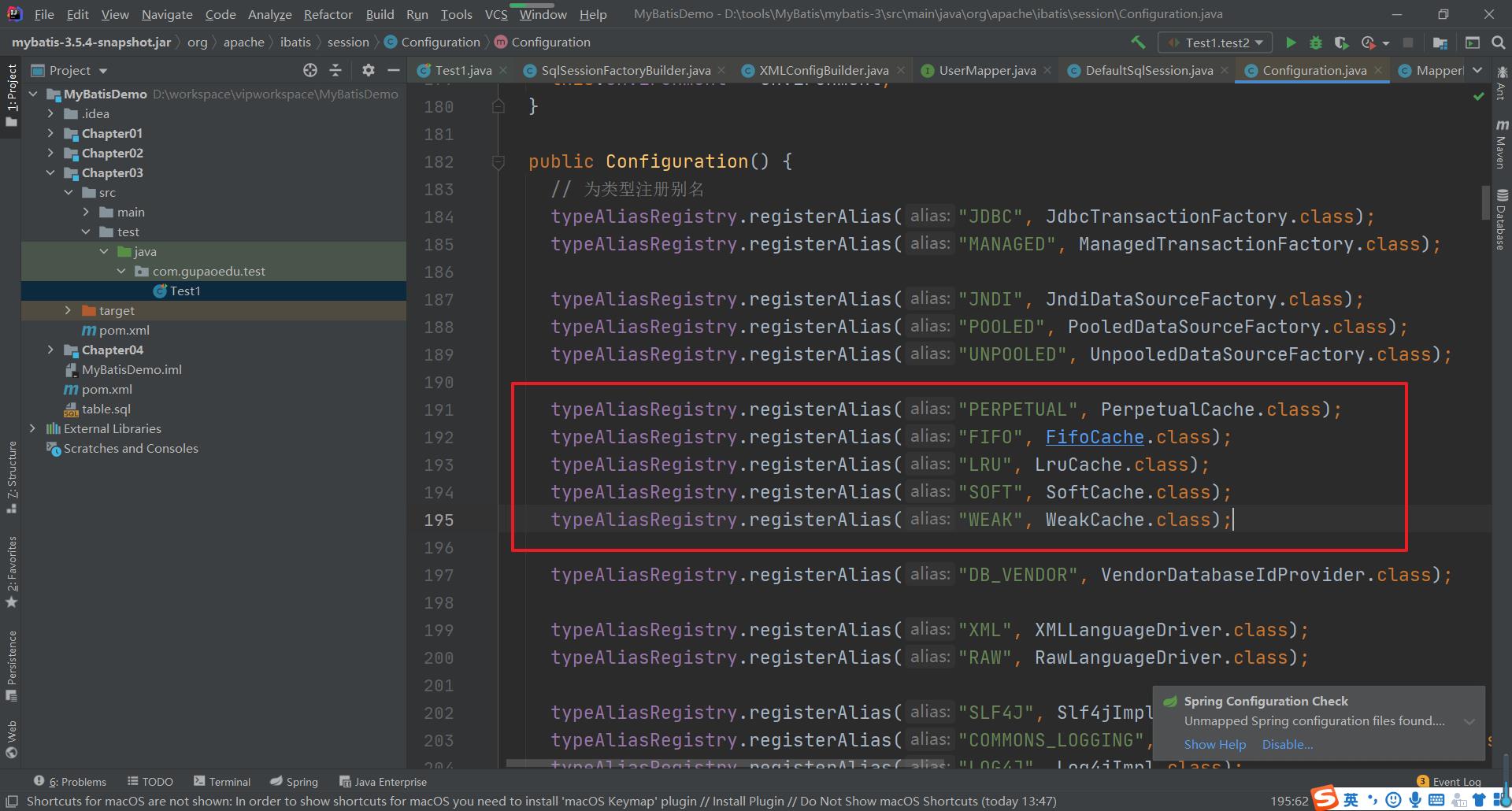
在解析settings标签的时候,设置的默认值有如下
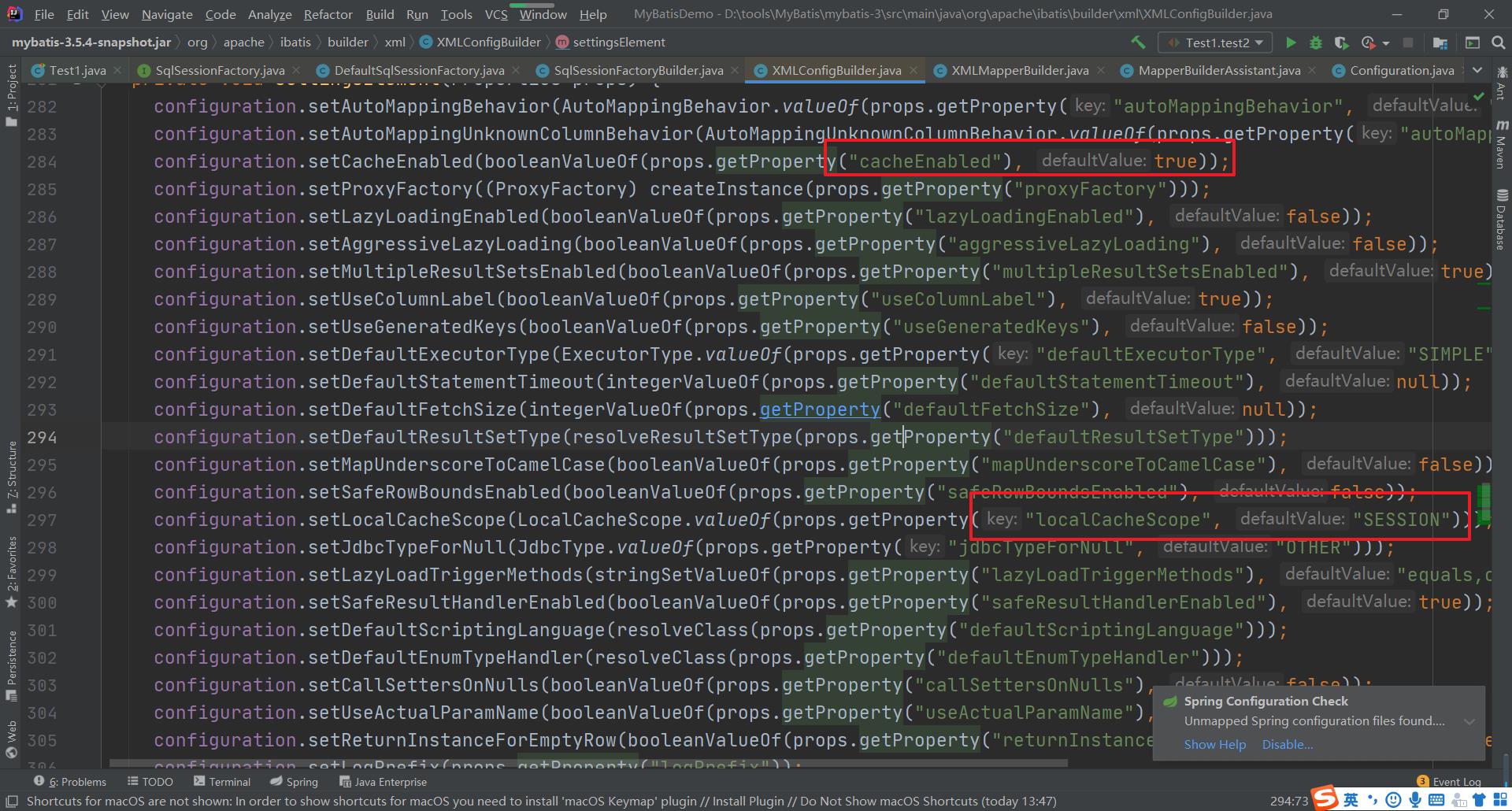
cacheEnabled默认为true,localCacheScope默认为 SESSION
在解析映射文件的时候会解析我们相关的cache标签

然后解析映射文件的cache标签后会在Configuration对象中添加对应的数据在
private void cacheElement(XNode context) {
// 只有 cache 标签不为空才解析
if (context != null) {
String type = context.getStringAttribute("type", "PERPETUAL");
Class<? extends Cache> typeClass = typeAliasRegistry.resolveAlias(type);
String eviction = context.getStringAttribute("eviction", "LRU");
Class<? extends Cache> evictionClass = typeAliasRegistry.resolveAlias(eviction);
Long flushInterval = context.getLongAttribute("flushInterval");
Integer size = context.getIntAttribute("size");
boolean readWrite = !context.getBooleanAttribute("readOnly", false);
boolean blocking = context.getBooleanAttribute("blocking", false);
Properties props = context.getChildrenAsProperties();
builderAssistant.useNewCache(typeClass, evictionClass, flushInterval, size, readWrite, blocking, props);
}
}
继续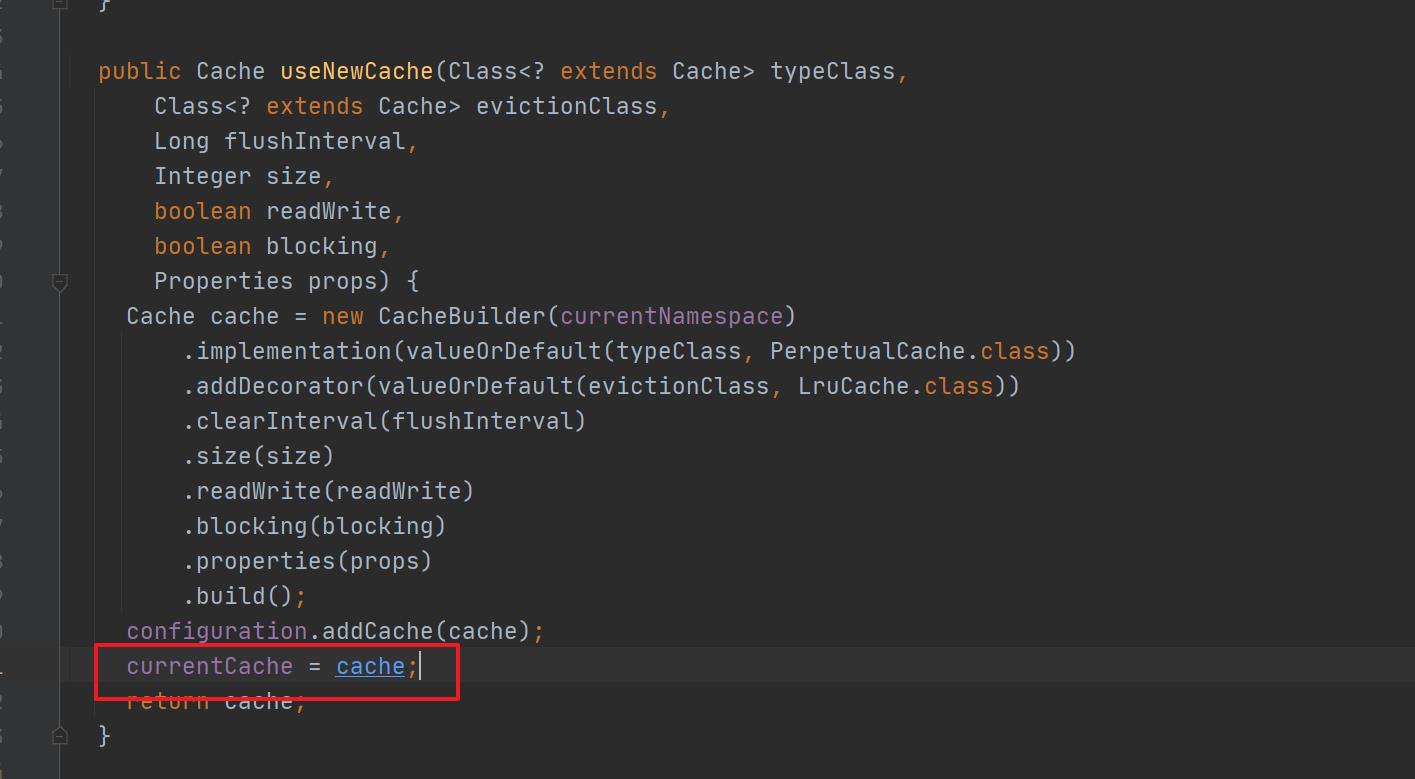
然后我们可以发现 如果存储 cache 标签,那么对应的 Cache对象会被保存在 currentCache 属性中。
进而在 Cache 对象 保存在了 MapperStatement 对象的 cache 属性中。
然后我们再看看openSession的时候又做了哪些操作,在创建对应的执行器的时候会有缓存的操作
public Executor newExecutor(Transaction transaction, ExecutorType executorType) {
executorType = executorType == null ? defaultExecutorType : executorType;
executorType = executorType == null ? ExecutorType.SIMPLE : executorType;
Executor executor;
if (ExecutorType.BATCH == executorType) {
executor = new BatchExecutor(this, transaction);
} else if (ExecutorType.REUSE == executorType) {
executor = new ReuseExecutor(this, transaction);
} else {
// 默认 SimpleExecutor
executor = new SimpleExecutor(this, transaction);
}
// 二级缓存开关,settings 中的 cacheEnabled 默认是 true
if (cacheEnabled) {
executor = new CachingExecutor(executor);
}
// 植入插件的逻辑,至此,四大对象已经全部拦截完毕
executor = (Executor) interceptorChain.pluginAll(executor);
return executor;
}
也就是如果 cacheEnabled 为 true 就会通过 CachingExecutor 来装饰executor 对象,然后就是在执行SQL操作的时候会涉及到缓存的具体使用。这个就分为一级缓存和二级缓存,这个我们来分别介绍
4.2 一级缓存
一级缓存也叫本地缓存(Local Cache),MyBatis的一级缓存是在会话(SqlSession)层面进行缓存的。MyBatis的一级缓存是默认开启的,不需要任何的配置(如果要关闭,localCacheScope设置为STATEMENT)。在BaseExecutor对象的query方法中有关闭一级缓存的逻辑
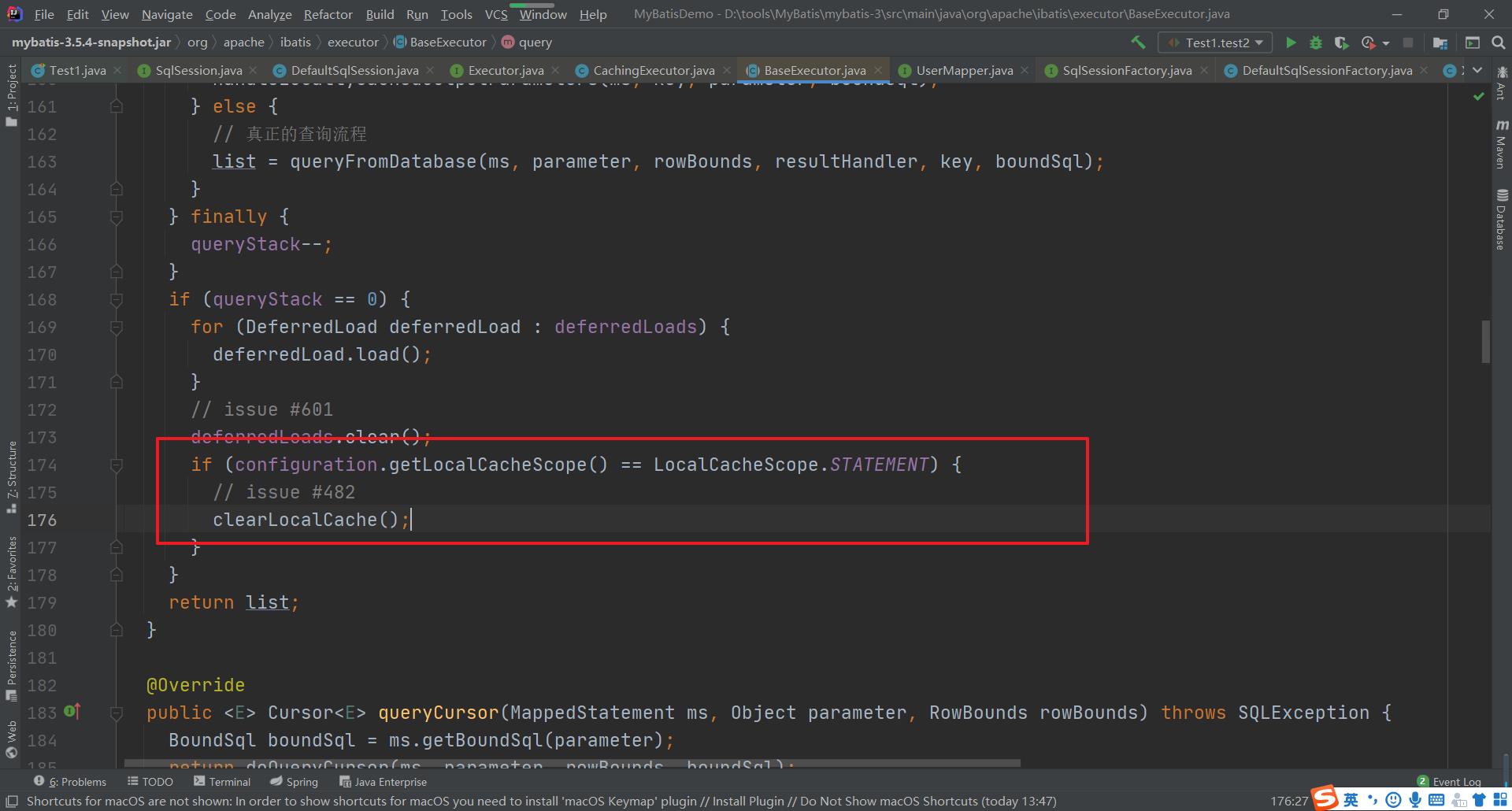
然后我们需要考虑下在一级缓存中的 PerpetualCache 对象在哪创建的,因为一级缓存是Session级别的缓存,肯定需要在Session范围内创建,其实PerpetualCache的实例化是在BaseExecutor的构造方法中创建的
protected BaseExecutor(Configuration configuration, Transaction transaction) {
this.transaction = transaction;
this.deferredLoads = new ConcurrentLinkedQueue<>();
this.localCache = new PerpetualCache("LocalCache");
this.localOutputParameterCache = new PerpetualCache("LocalOutputParameterCache");
this.closed = false;
this.configuration = configuration;
this.wrapper = this;
}
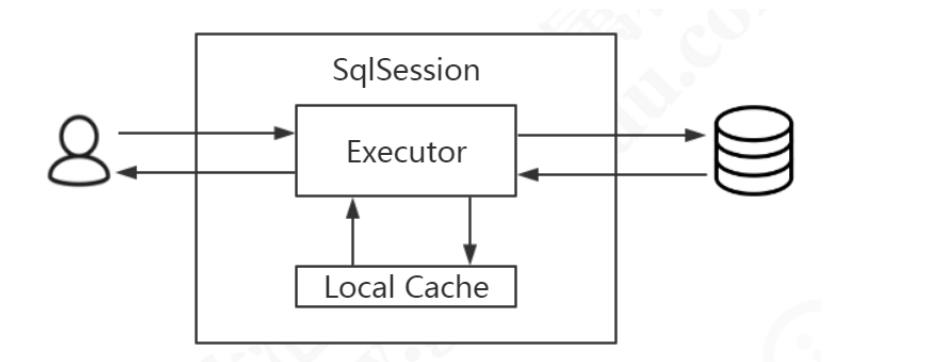
一级缓存的具体实现也是在BaseExecutor的query方法中来实现的
public <E> List<E> query(MappedStatement ms, Object parameter, RowBounds rowBounds, ResultHandler resultHandler, CacheKey key, BoundSql boundSql) throws SQLException {
// 异常体系之 ErrorContext
ErrorContext.instance().resource(ms.getResource()).activity("executing a query").object(ms.getId());
if (closed) {
throw new ExecutorException("Executor was closed.");
}
if (queryStack == 0 && ms.isFlushCacheRequired()) {
// flushCache="true"时,即使是查询,也清空一级缓存
clearLocalCache();
}
List<E> list;
try {
// 防止递归查询重复处理缓存
queryStack++;
// 查询一级缓存
// ResultHandler 和 ResultSetHandler的区别
list = resultHandler == null ? (List<E>) localCache.getObject(key) : null;
if (list != null) {
handleLocallyCachedOutputParameters(ms, key, parameter, boundSql);
} else {
// 真正的查询流程
list = queryFromDatabase(ms, parameter, rowBounds, resultHandler, key, boundSql);
}
} finally {
queryStack--;
}
if (queryStack == 0) {
for (DeferredLoad deferredLoad : deferredLoads) {
deferredLoad.load();
}
// issue #601
deferredLoads.clear();
if (configuration.getLocalCacheScope() == LocalCacheScope.STATEMENT) {
// issue #482
clearLocalCache();
}
}
return list;
}

一级缓存的验证:
同一个Session中的多个相同操作
@Test
public void test1() throws Exception{
// 1.获取配置文件
InputStream in = Resources.getResourceAsStream("mybatis-config.xml");
// 2.加载解析配置文件并获取SqlSessionFactory对象
SqlSessionFactory factory = new SqlSessionFactoryBuilder().build(in);
// 3.根据SqlSessionFactory对象获取SqlSession对象
SqlSession sqlSession = factory.openSession();
// 4.通过SqlSession中提供的 API方法来操作数据库
List<User> list = sqlSession.selectList("com.gupaoedu.mapper.UserMapper.selectUserList");
System.out.println(list.size());
// 一级缓存测试
System.out.println("---------");
list = sqlSession.selectList("com.gupaoedu.mapper.UserMapper.selectUserList");
System.out.println(list.size());
// 5.关闭会话
sqlSession.带你彻底搞懂MyBatis的底层实现之binding模块